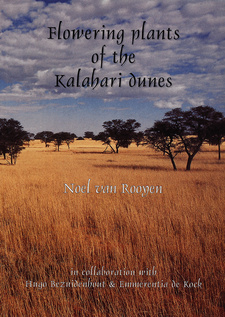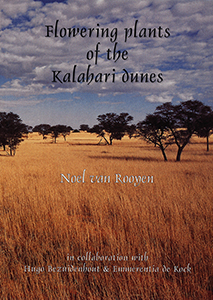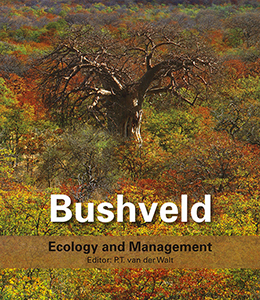Flowering plants of the Kalahari dunes, by Noel van Rooyen

Flowering plants of the Kalahari dunes, by Noel van Rooyen. Ekotrust cc / Botanical Society of South Africa. Thatchers Field, South Africa, 2001. ISBN 0620273763 / ISBN 0-620-27376-3 / ISBN 9780620273763 / ISBN 978-0-620-27376-3
As a tourist and botanical destination, the Kalahari has always been unique. Besides the presence of game, the remoteness and sense of wilderness will always attract the appreciative visitor to the area. In his guide, Flowering plants of the Kalahari dunes, Noel van Rooyen shows why.
The term Kalahari is a corruption of the word 'Kgalagadi', the name of a black tribe who inhabit Botswana. In the Setswana language the word means 'always dry', although the meaning of the word has been interpreted in a variety of other ways, such as 'wilderness', 'thirstland', 'the land that has dried up' or 'salt pans'. Geographically the name is applied in a very loose sense. The area covered by Kalahari sands extends over some 2.5 million km² of the interior of central southern Africa. These wind-blown sands are the largest continuous stretch of sand in the world. The area constituting the Kalahari dune veld is but a small part, in the south-western corner of this vast expanse, and includes the extensive sheet of aeolian sand of south-western Botswana, together with the adjacent areas of Namibia and South Africa. This region is characterised by long sand dunes running in parallel rows, in a northwest-southeast direction, and rising in places some 15-30 m above the dune valleys or "streets" between them. The Kalahari is not a true desert but rather an arid savanna and is quite densely covered with grasses, shrubs and trees. It is regarded as one of Africa's last wilderness areas and is probably one of the largest relatively undisturbed arid savannas in Africa. Inaccessibility, the lack of prominent landmarks and the lack of surface water for most of the year, have contributed to minimal human impact and the preservation of the area.
Example: FABACEAE
1. (Indigofera alternans)
Pod-bearing family, pea family, springbokopslag, skaapertjie.
A small, flat, annual plant forming mats up to 500 mm in diameter. The long stems are covered with fine hairs. Leaves are pinnately compound, terminal leaflet obovate, light-green above and grey-green and covered with hairs below. Flowers pink to deep red. Fruit a small, pencil-like pod, bent backwards, Up to 10 mm long. Flowering time is from summer into autumn. Sometimes eaten as a vegetable. Widespread throughout southern Africa in sandy soils, along roadsides and disturbed places. Prominent along roads in the Kgalagadi Transfrontier Park after good summer rains. The genus Indigofera is one of the largest genera in the Kalahari, with thirteen species having been recorded in the Kgalagadi Transfrontier Park.
2. Indigofera auricoma
A prostrate to erect, perennial herb with stems up to 500 mm long arising from the woody basis. Leaves are imparipinnately compound, leaflets linear to lance-shaped, young leaves golden-green and hairy on the upper surface. Flowers pink, the standard hairy and the keel slightly woolly at the top edge. Flowering time is in summer. Found in sandy, calcareous soils on calcrete outcrops and near pans in the Kalahari.
3. Indigofera charlieriana var. charlieriana
A prostrate to erect herb, up to 300 mm tall. Leaves are pinnately compound with long and narrow leaflets. Small flowers are pink or purple. Pods are produced in clusters, curved backwards, linear with a ridge down the middle, 20-30 mm long. Flowering time is in late summer. Widespread in deep sandy soils of the Kalahari dune veld. [...]
This is an excerpt from Flowering plants of the Kalahari dunes, by Noel van Rooyen.
Title: Flowering plants is one of few botanical guides to the dunes of the Kalahari region
Author: Noel van Rooyen
Publisher: Ekotrust cc / Botanical Society of South Africa
Thatchers Field, South Africa, 2001
ISBN 0620273763 / ISBN 0-620-27376-3
ISBN 9780620273763 / ISBN 978-0-620-27376-3
Softcover, 15 x 21 cm, 215 pages, countless colour photos
van Rooyen, Noel im Namibiana-Buchangebot
Flowering plants of the Kalahari dunes
Flowering plants of the Kalahari dunes illustrates 236 plant species, concentrating on the common and conspicuous species.
Bushveld: Ecology and Management
Seventeen of South Africa's most prominent bush experts share their knowledge about ecology and management of the Bushveld.


